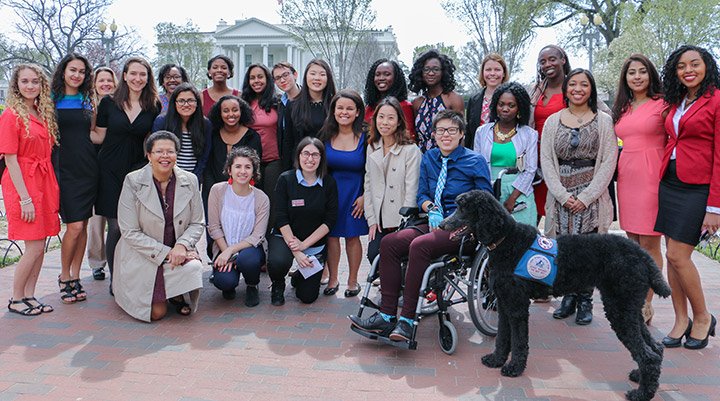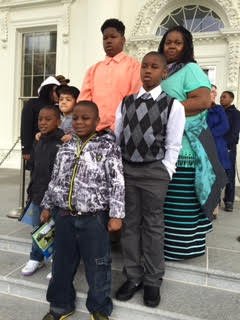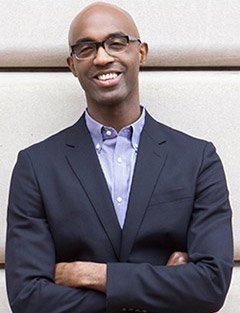Swarthmore Goes to Washington

Members of the student group Women of Color Kick Ass with staff from the Women’s Resource Center and three faculty members toured the White House in late March. Photo by Tanya Jackson.
Mark Wallace was expecting The West Wing. What he experienced was more Parrish Parlors.
“It reminded me of Parrish Hall, honestly,” the professor of religion says of the White House, to which he and community partners brought 50 schoolchildren from Chester, Pa., earlier this month.
“But the ‘wow factor’ lay in the human scale and intimacy of the place,” he says. “Our group was awestruck.”
The students are part of the College's Dare 2 Soar program and the College Access Center of Delaware County. Given the age range, from five years old to 18, their reactions to the White House varied. But the oil portraits of past presidents, including one of a melancholy John F. Kennedy, piqued the interest of many.
“They had lots of questions about the portraits — who’s this, what’s going on there, what’s he thinking?” says Wallace. “In those moments, history came alive.”
Their visit was one of three separate stops by College community members to the White House in recent weeks. Also keeping it 1600: Joseph Nelson, visiting assistant professor of educational studies, who shared his perspectives on black boyhood before a panel of children’s media executives in early April; and the student group Women of Color Kick Ass (WOCKA), which toured with staff from the Women’s Resource Center (WRC) and three faculty members in late March.

Wallace arranged his visit through a friend at the White House, and extended the opportunity to the children whom his Religion and Ecology students tutor in a community-based-learning initiative. The group also visited the Martin Luther King, Jr., Memorial and the National Zoo. But the headliner was paying a call to the First Family.
“Comment of the day: You mean we don’t get to see the daughters’ bedrooms or the kitchen?!” adds Cynthia Jetter '74, director of community partnerships and planning from the Lang Center for Civic & Social Responsibility, which supported the trip.
Nelson's trip to Washington came via invitation, as he was asked to speak before 40 executives from companies such as Mattel, Disney, and Lego and the producers of movies like Star Wars. The executives sought fresh ideas to boost their appeal among and inclusion of children of color.
“They were very receptive to new ideas,” says Nelson, who offered ideas from a recently published article in Harvard Educational Review, “Reimaging Black Boyhood: Toward a Critical Framework for Educational Research” [pdf], which he co-wrote with Michael Dumas, assistant professor in the Graduate School of Education and the African American Studies Department at University of California, Berkeley.
“They want to get better at including wider representations of children in their media campaigns,” he says, “and I was eager to support their efforts to challenge stereotypical perception of black boys.”
While his official business went smoothly, the logistics of Nelson’s trip were challenging.

“I had to go through four different checkpoints, get scanned, show my ID a few times,” he says. “Then once you go inside, you can’t use your cell phone. Four hours with no communication to the outside world. You don’t know how to plan for that. But I felt safe.”
The 20 students from WOCKA spent their checkpoint time getting to know one another and the faculty and staff members, also bonding en route to the National Museum of Women in the Arts and the Eisenhower Executive Office Building. Their highlight, though, was the mentoring lunch and discussion they shared with women of color who took a variety of paths to their array of responsibilities in the White House.
Nina Harris, violence prevention educator and advocate and advisor to the Women’s Resource Center, and Becca Bernstein, Title IX fellow, arranged the trip through personal friendships. The students got to interact with White House Chief of Staff members, as well as representatives from public engagement, economics and finance, police, and more.
For Taylor Morgan '19, of Brick, N.J., the gravity of the moment struck as soon as she walked into the conference room.
“I experienced an overwhelming sense of power from being in a room full of such powerful and influential women who urged WOCKA members to remember they were once exactly like us,” says Morgan. “They encouraged us to see ourselves in them, because they, too, once did now know ‘what they wanted to do when they grow up.’”
“These women were all so down to earth, so real, and so relatable” adds Roseann Liu, visiting assistant professor of Educational Studies. “They all talked about how they never would have dreamed that they would one day work in THE White House. But being faithful to their passions and interests and doing good work eventually led them there.”
Their common denominator, says Désirée Díaz, assistant professor of Spanish, is “an obvious passion for and dedication to their jobs and the issues they care about.”
The conversation affirmed conversations WOCKA was already having on campus and created a kinship among the students, faculty, and staff that they can build on at Swarthmore, says Harris. It was, at once, deeply personal and universal.
“Professionally, academically, and developmentally, it really helped to center the work that they do here,” says Harris, “and to know the reach that they can have one day.”


